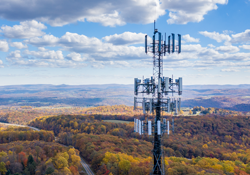Legacy networks such as 3G and 4G are adequate for basic connectivity. Think of connecting your laptop to the Internet, running a simple cloud solution, or connecting various mobile and industrial devices in the field. However, due to issues with coverage, security, and high management overheads, these networks are not ideal for many modern industrial IoT (IIoT) applications.
To overcome these issues, many companies have shifted to using private cellular networks with 4G LTE and 5G technologies that are compatible with public cellular networks. This evolution is, in fact, the result of a long series of initiatives aimed at improving connectivity in America and building better, more resilient communications infrastructures.
While connectivity rates should continue to improve over time, businesses must still determine if a hybrid or PLTE network is best for them and what advantages these networks can offer. Here we provide an overview of these technologies and what you need to know about how they can help you.
A hybrid network is a system that uses more than one networking technology or topology. If your office provides workers with WiFi connectivity as well as ethernet cables, that is an example of a hybrid network. Your mobile device can connect to an office network using WiFi, but it can also connect to the Internet using a SIM. This is also an example of hybrid connectivity, as Multi-Protocol Label Switching (MPLS) technologies are what allow users to route their Internet traffic over different technologies.
In the context of public vs. private networks, however, a hybrid private network (hybrid PLTE) is one in which an organization does not have special access to or ownership over the wireless spectrum, base stations, or other network infrastructure that it uses to send and receive data. The organization shares or operates different parts of the network(s) they use, with the other parts owned, shared, or operated by other entities.
In contrast, an LTE network is fully private when an organization owns the spectrum and all of the infrastructure it uses. Hybrid and fully private LTE networks use wireless spectrum along with LTE or 5G cellular connectivity to provide voice and data services to connected devices such as routers, gateways, embedded sensors, and smartphones.
LTE is a 4G technology and is secure, reliable, and fast. 5G is newer and offers many performance advantages over LTE, such as faster data transmission, lower levels of latency, and the ability to connect to more devices. We talk more about the benefits of 5G and fully private or hybrid LTE running on 5G for IIoT applications later in this post.
PLTE can reduce the fragmentation and inefficiencies that are created when enterprises have multiple networks running at once, as it can be used to run a wide range of devices and applications on a single network. WiFi will still enjoy heavy usage over the years to come, but hybrid and PLTE networking are trending toward becoming the norm as they combine the benefits of wireless and fixed connectivity in a single, low-cost, highly manageable, and customizable system.
In terms of function, PLTE networks work in much the same way public LTE networks. Smartphones, sensors, and other edge devices transmit data to a cellular base station, an access point, or another endpoint of a network using the wireless spectrum. That infrastructure then carries the transmitted data via a secured wired connection to the enterprise’s internal network, from which it can be sent to different cloud services or applications.
The main difference between hybrid, public, and private LTE networks comes down to:
With PLTE, you can own, operate, or enjoy some level of preferential or priority access to the infrastructure and spectrum/bandwidth you need.
The types of PLTE include:
As with setting up a personal WiFi connection, anyone may operate their own PLTE network.
To set up a PLTE network, you will require:
Before your smartphone, embedded sensor, router, or other field devices can connect to a PLTE, it must be able to operate on a spectrum that your network uses and have a unique SIM card for identification and communications. MNOs typically provide SIM cards for devices used on the MNO’s network. SIM cards can be set up to enable your devices to connect to your PLTE as and when needed and then switch to a public network when it cannot or does not need to connect to your private network. Edge devices that are certified to use the CBRS can connect to private CBRS LTE networks.
Setting up a PLTE requires a greater up-front investment than setting up a private WiFi network, but it can deliver better wireless coverage underground, inside facilities, and over large geographic areas. PLTE networks also use the same technology as public cellular networks, allowing for easier hand-off to public networks should your devices ever leave their private network’s coverage area.
Many companies may start off using a public LTE network and switch to their own PLTE once it is fully built out. Public networks can also act as a backup should your PLTE ever go down, since handoff to an MNO’s public network can happen automatically using your device’s SIM.
Many businesses are also turning to PLTE networks for applications that cannot be performed effectively with WiFi. WiFi connections are prone to errors and are often unreliable, and they do not provide the coverage that 4G and 5G can, especially when it comes to indoor coverage, lowering latency, supporting applications that require rapid processing, and differentiating between different types of traffic. All packets look the same over WiFi, but PLTE networks allow the prioritization of traffic based on the application or use case in question.
WiFi is also intrinsically less secure than PLTE networks, which require stronger authentication and authorization in order to connect to a network.
5G was designed to support the high device density and low latency/fast data transfer required by the emerging technologies of yesterday, the data-intensive applications that are commonplace today, and the cutting-edge applications of tomorrow.
With PLTE on a 5G network, moving (nomadic) endpoints can continuously move within a covered area while enjoying seamless connectivity. Thanks to nativity mobility built into these networks, it is not necessary to stop and reestablish a new connection. The benefits of time-division duplexing (TDD), spatial diversity, path redundancies, and increasing channel capacity to improve signal quality and reliability also come into play with 5G PLTE connectivity.
With a 5G PLTE network, you can enjoy ultra-low latency with the high bandwidth needed to run cutting-edge smart devices and the applications they use. Your vendor can even create network slices that allow you to partition your network into public and PLTE instances, over which you can dynamically direct traffic based on cost or need.
The operational ease, flexibility, and low cost of PLTE networks (thanks to the use of low power low throughput deployments) using existing cloud-native 5G infrastructures are the driving force behind many industries adopting this new tech.
In the next section, we outline several real-life applications for these benefits.
The following use cases highlight some of the ways in which organizations can take advantage of fast, secure, and easy-to-manage networks:
Thinking of drawing up PLTE plans for your organization? Here is a brief list of important points to consider.
Dense IIoT device and sensor networks are empowering a new generation of applications that are transforming the industrial and consumer landscapes. The 5G networks of tomorrow will be backwards compatible with today’s 4G PLTE, meaning a professionally configured PLTE network today can help you avoid having stranded assets 3-5 years in the future.
PLTE networks are the logical choice for many industries, especially those in which physical or regulatory obstacles lead to a slow rollout of connectivity. PLTE can provide you with the security, speed, and high performance at the edge – along with significant cost savings over widespread WiFi – to help drive success.
Kajeet can work with your existing cellular provider or an MNO of choice to get your organization fitted with the PLTE network configuration that works for you.
Check out our private wireless networking page to learn about the benefits of a hybrid or fully private LTE network today and to consult with a Solutions Engineer about your organization’s needs.


